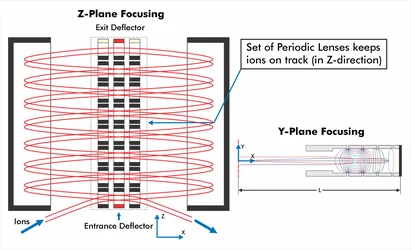Folded Flight Path–The Key to Unlocking High Resolution
LECO’s patented Folded Flight Path® (FFP®) technology has celebrated over ten years of mass spectrometry breakthroughs. This ingenious concept uses multi-reflecting technology to strip away the oversized flight tubes from traditional high resolution Time-of-Flight (TOF) mass spectrometers and packs an impressive resolving power of 25,000 into a surprisingly small footprint. Ultra High Resolution mode enables the FFP instruments to reach resolving powers of over 50,000 with flight paths equivalent of 40 m without a single increase in lab space.
This video is hosted on Vimeo, an external website. If it does not load, you may view it here.
What is the Folded Flight Path?
TOF mass spectrometry has several major advantages in the field of mass spectrometry.
- Unlimited mass range: The mass analyzer itself is not a limiting factor for the mass range of ions.
- Full mass range spectra: All ion masses present in the extraction region are recorded in the single spectrum.
- No spectral skewing: There is no scan time, as time can be measured extremely fast, which results in no skewing.
The resolving power of a TOF mass spectrometer has always been determined by how narrow the peak widths are and how long the ions’ flight times are. With peak widths essentially limited by real-world constraints, the only way to significantly increase resolving power is to increase the flight time.

Traditional high resolution TOF mass spectrometers use multi-reflections of ions using mirrors and grids defining electrical fields of different strengths within the reflection. Even the most transparent grids will lead to significant ion losses, with more reflections weakening the resulting signals further.
The FFP went in a different direction.
Using a series of planar gridless mirrors and an array of Einzel focusing electrostatic lenses, the FFP is able to direct ions through 16 lenses and 32 reflections, creating a 20 m ion path within a 30 in x 6 in x 4 in vacuum chamber. In Ultra High Resolution mode, the ions are reversed at the end and sent through the array again, doubling the flight path and the resolving power.


Encoded Frequent Pushing®: Improving Duty Cycle in the Folded Flight Path® High Resolution Time-of-Flight Mass Spectrometry
LECO’s unique orthogonal accelerator technology expands analytical capabilities of gas chromatography high-resolution time-of-flight mass spectrometers with significant increases in sensitivity, expanded dynamic ranges, improved mass accuracy and lower levels of interference noise. Learn more about Encoded Frequent Pushing® (EFP) and its enhancements and benefits to high resolution TOFMS combined with LECO’s Folded Flight Path technology.
